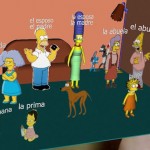 This is our third Spanish 101 experiment we conducted with the aid of Augmented Reality models (experiment 1, experiment 2). Dr. Socorro Zaragoza wanted to determine what effects does AR have on student language speaking, writing, reading, listening skills as well as the language comprehension.
This is our third Spanish 101 experiment we conducted with the aid of Augmented Reality models (experiment 1, experiment 2). Dr. Socorro Zaragoza wanted to determine what effects does AR have on student language speaking, writing, reading, listening skills as well as the language comprehension.
Each experiment corresponded to the textbook lesson for SPA 101 and the goal of each experiment was to determine if Augmented Reality influenced student learning. The topic of the third lesson/experiment was family members (miembros de la familia). Dr. Zaragoza suggested that we use “The Simpsons” as a scene to portray family members and family relations. This worked quite well as we found most of the 3D models we needed on Google 3D Marketplace. The ones we couldn’t find, we created out of 2D images. In addition to the 3D models, we decided to integrate vocabulary into the augmented reality scene in order to eliminate the split attention effect (Cognitive Load Theory). Split attention effect results when students are interacting with the augmented reality model and then referencing the textbook for the vocabulary while still holding the mental image of the model in their working memory. This was observed in previous two experiments.
Overall, this was our most successful collaborative educational augmented reality project so far. The students who participated in the experiment were amazed by the models and seemed very engaged during the lesson. We should be analyzing the data (interviews, pre, post and retention test) soon and doing the writeup in upcoming months. Read the full post, watch the experiment video and download the Augmented Reality scene files here.

2 Responses to The Role of Augmented Reality in Language Acquisition Part 3